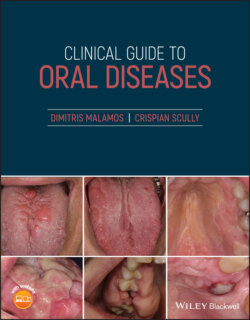Читать книгу Clinical Guide to Oral Diseases - Crispian Scully - Страница 53
Case 4.6
ОглавлениеFigure 4.6
CO: A 67‐year‐old woman was presented with multiple bullae on her mouth which could easily break and leave painful ulcerations and bad breath as well.
HPC: The oral lesions appeared one year ago, as flaccid small bullae on the floor of the mouth and buccal mucosae which were easily broken with mastication, thus leaving scattered painful ulcerations. These lesions were accompanied by bad breath.
PMH: Chronic lymphocytic leukemia was diagnosed two months ago and partially responded to two courses of a combined chemotherapy with fludarabine, cyclophosphamide, and rituximab together with plasmapheresis.
OE: Multiple superficial erosions and not intact bullae were found on her palate, floor of the mouth and buccal mucosae. Her gingivae were erythematous, swollen, and bled with probing (Figure 4.6). Nikolsky sign was positive as a small bulla which appeared with gingival rubbing, but is easily broken with slight pressure. Her oral hygiene was poor, causing periodontal problems and caries in her remaining teeth. Gingival biopsy revealed acantholysis at the lower epithelial layers with intra‐epithelial bulla formation and positive immune‐fluorescence (direct and indirect). The bad breath like rotten fruit was obvious and remained unchanged over the days.
Q1 Which is the main cause of her bad breath?
1 Pemphigus vegetans
2 Paraneoplastic pemphigus
3 Benign mucous membrane pemphigoid
4 Caries
5 Periodontitis
Answers:
1 No
2 Paraneoplastic pemphigus was the cause of halitosis. This bad breath was attributed to excessive volatile gas production from numerous pathogenic bacteria which grew within the inflamed oral ulcerations in this woman with a positive history of hematological malignancy.
3 No
4 No
5 No
Comments: The halitosis from pemphigus vulgaris, pemphigoid, or paraneoplastic lesions is indistinguishable and the diagnosis of the responsible bullous disorder should be based on the patient's clinical and histological characteristics, immunological profile and association or not with serious diseases. The bad breath was also reinforced by the patient's chronic periodontitis, caries, and inadequate tooth brushing.
Q2 Which of the neoplasms below is mostly related with this bullous condition?
1 Carcinomas
2 Non‐Hodgkin lymphoma (NHL)
3 Thymoma
4 Sarcomas
5 Melanomas
Answers:
1 No
2 NHL is the most frequent hematologic neoplasm that is associated with paraneoplastic pemphigus.
3 No
4 No
5 No
Comments All these tumors usually preexist the oral lesions in paraneoplastic pemphigus, with a declining association starting with NHL, followed by a chronic lymphocytic leukemia, carcinomas, sarcomas, and least likely, melanomas.
Q3 Which auto‐antibodies (abs) are characteristics of a paraneoplastic pemphigus?
1 Desmoglein 1 abs
2 Desmoglein 3 abs
3 Anti‐smooth muscles abs
4 Anti‐neutrophil cytoplasmic abs
5 Plakins (envo; peri; desmo) abs
Answers:
1 No
2 Desmoglein 3 rather than 1 Abs have been implicated with the pathogenesis of paraneoplastic pemphigus.
3 No
4 No
5 Envoplakins (210 kDa); periplakins (190 kDa) and desmoplakins (250 kDa) play a crucial role in combination with cellular immunity in the pathogenesis of paraneoplastic pemphigus.
Comments: Auto abs against desmoglein 1 are detected in pemphigus foliaceus but rarely in paraneoplastic. Anti‐smooth muscle and anti‐neutrophils cytoplasmic abs are not found in paraneoplastic pemphigus, but are pathognomonic of autoimmune liver disease and necrotizing vessel vasculitides.
